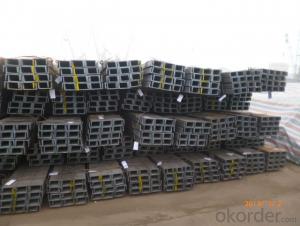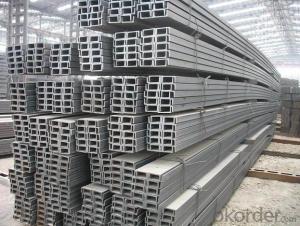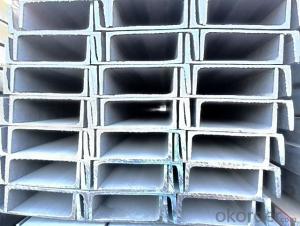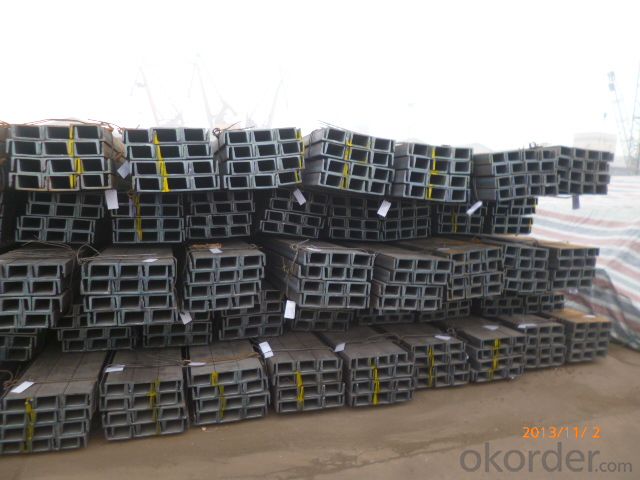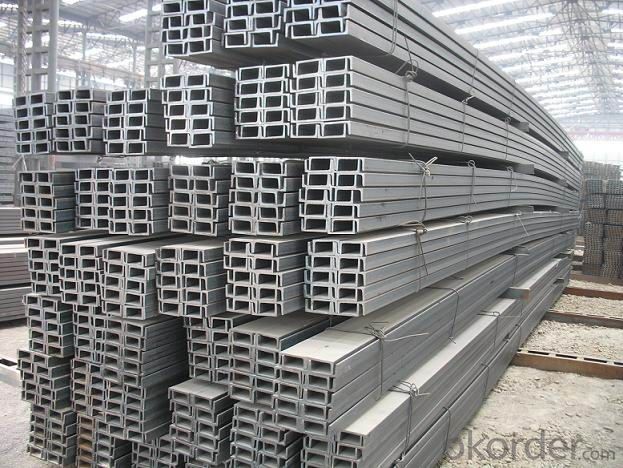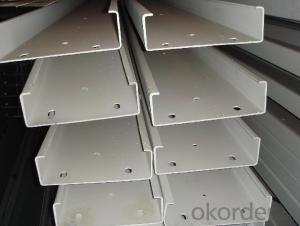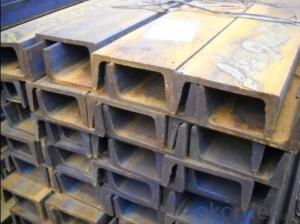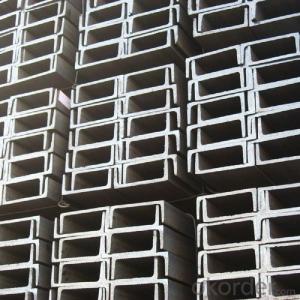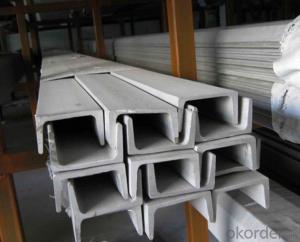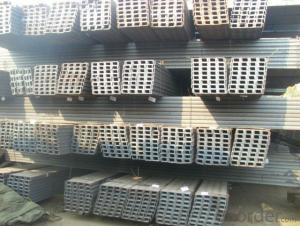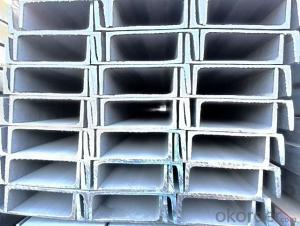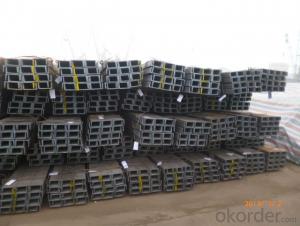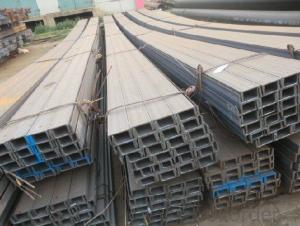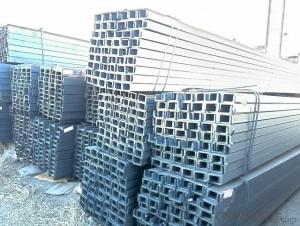Hot Rolled JIS U-Channels with Lowest Price
- Loading Port:
- Tianjin
- Payment Terms:
- TT OR LC
- Min Order Qty:
- 25 m.t
- Supply Capability:
- 10000 m.t/month
OKorder Service Pledge
OKorder Financial Service
You Might Also Like
Specification
OKorder is offering high quality Hot Rolled Steel U-Channels at great prices with worldwide shipping. Our supplier is a world-class manufacturer of steel, with our products utilized the world over. OKorder annually supplies products to European, North American and Asian markets. We provide quotations within 24 hours of receiving an inquiry and guarantee competitive prices.
Product Applications:
The MS Channel can be applied to construction of warehouses, workshops, sport stadiums and car parks etc.The hot rolled channel steel belongs to carbon structural steel which is applied to in the field of construction and machinery.In details, the hot rolled channel steel is usually used for arch-itechtural structure, and they could be welded in order to support or hang a vari-ety of facilities. They are also usually used in combination with I beam. Generally,the hot rolled channel steel we supply must possess perfect welding property, riveting property and mechanical property and so on.
Product Advantages:
OKorder's Steel U-Channels are durable, strong, and resist corrosion.
Main Product Features:
· Premium quality
· Prompt delivery & seaworthy packing (30 days after receiving deposit)
· Corrosion resistance
· Can be recycled and reused
· Mill test certification
· Professional Service
· Competitive pricing
Product Specifications:
1.We supply high quality MS Channel at reasonable price, including Chinese standard, Japanese standard and so on.
2. The detailed sections of MS Channel as per GB standard.are shown in the table-1:
GB U CHANNEL | Standard | Sectional | Dimension |
| Mass: |
(mm) | (mm) | (mm) | (mm) | ||
50X37 | 50 | 37 | 4.50 | 7.0 | 5.438 |
63X40 | 63 | 40 | 4.80 | 7.5 | 6.634 |
80x43 | 80 | 43 | 5.00 | 8.0 | 8.045 |
100x48 | 100 | 48 | 5.30 | 8.5 | 10.007 |
120x53 | 120 | 53 | 5.50 | 9.0 | 12.059 |
140x58 | 140 | 58 | 6.00 | 9.5 | 14.535 |
140x60 | 140 | 60 | 8.00 | 9.5 | 16.733 |
160x63 | 160 | 63 | 6.50 | 10.0 | 17.240 |
160x65 | 160 | 65 | 8.50 | 10.0 | 19.752 |
180x68 | 180 | 68 | 7.00 | 10.5 | 20.174 |
180x70 | 180 | 70 | 9.00 | 10.5 | 23.000 |
200x73 | 200 | 73 | 7.00 | 11.0 | 22.637 |
200x75 | 200 | 75 | 9.00 | 11.0 | 25.777 |
220x77 | 220 | 77 | 7.00 | 11.5 | 24.999 |
220x79 | 220 | 79 | 9.00 | 11.5 | 28.453 |
250x78 | 250 | 78 | 7.00 | 12.0 | 27.410 |
250x80 | 250 | 80 | 9.00 | 12.0 | 31.335 |
250x82 | 250 | 82 | 11.00 | 12.0 | 35.260 |
280x82 | 280 | 82 | 7.50 | 12.5 | 31.427 |
280x84 | 280 | 84 | 9.50 | 12.5 | 35.823 |
280x86 | 280 | 86 | 11.50 | 12.5 | 40.219 |
300x85 | 300 | 85 | 7.50 | 13.5 | 34.463 |
300x87 | 300 | 87 | 9.50 | 13.5 | 39.173 |
300x89 | 300 | 89 | 11.50 | 13.5 | 43.883 |
Table-1
FAQ:
Q1: Why buy Materials & Equipment from OKorder.com?
A1: All products are carefully selected from China's most reliable manufacturing enterprises. Through its ISO certifications, OKorder.com adheres to the highest standards and a commitment to supply chain safety and customer satisfaction. We can guarantee the quality!
Q2:What's your payment terms ?
A2: We can accept T/T,LC at sight and time LC.
Q3: Can you offer the third part inspection certificates ?
A3: Yes, we can apply third part inspection before shipping, such as SGS, BV, etc .
Images:
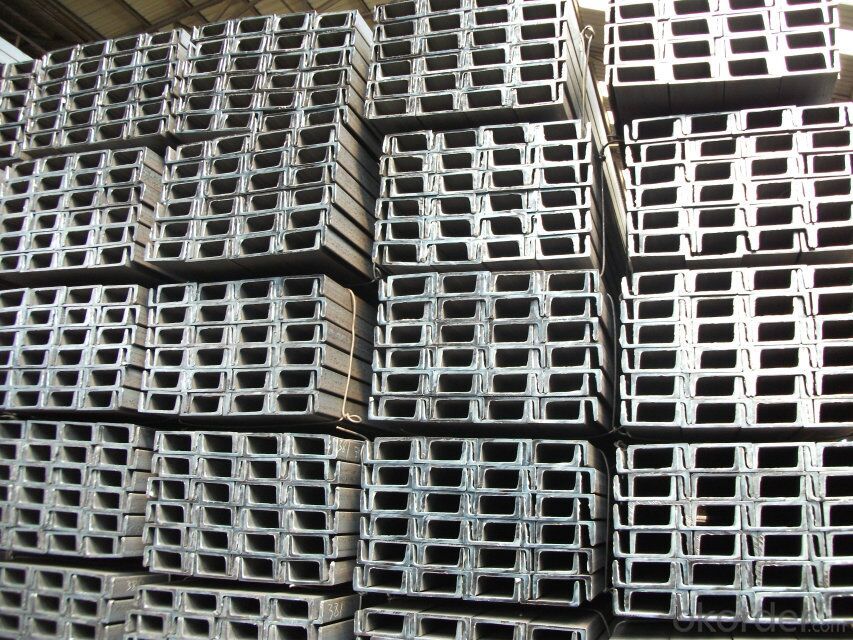
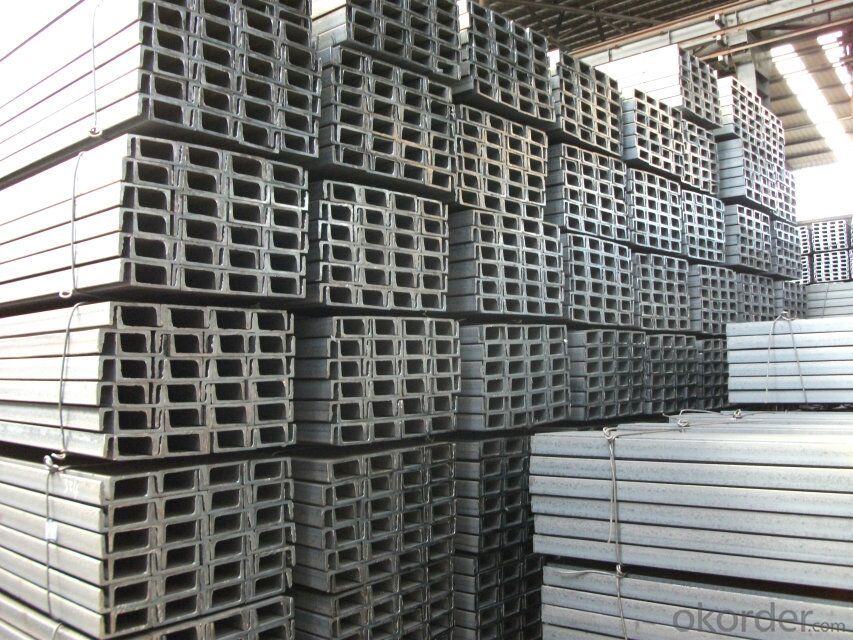
- Q: Can steel channels be used in the aerospace parts manufacturing industry?
- Yes, steel channels can be used in the aerospace parts manufacturing industry. Steel channels are often used in the construction of aircraft structures and components due to their high strength, durability, and resistance to deformation. They can be used in various applications such as framing, support structures, and reinforcement for critical aerospace parts. Steel channels provide structural integrity and stability, allowing for the safe and reliable operation of aerospace vehicles. Additionally, steel channels can be easily fabricated and welded, making them an ideal choice for the aerospace industry, where precision and quality are of utmost importance.
- Q: What are the different welding methods for steel channels?
- There are several different welding methods that can be used for steel channels, depending on the specific application and desired results. Some of the most common welding methods for steel channels include: 1. Shielded Metal Arc Welding (SMAW): Also known as stick welding, SMAW involves using an electrode coated in flux to create an arc between the electrode and the base metal. This method is versatile and can be used for both thick and thin steel channels, making it suitable for a wide range of applications. 2. Gas Metal Arc Welding (GMAW): Commonly referred to as MIG welding, GMAW uses a continuous wire electrode that is fed through a welding gun. The wire is melted and joined with the base metal while being shielded by a gas, typically a mixture of argon and carbon dioxide. This method is known for its speed and efficiency, making it ideal for high-volume production of steel channels. 3. Flux-Cored Arc Welding (FCAW): Similar to GMAW, FCAW utilizes a continuous wire electrode, but instead of using a shielding gas, it uses a flux-filled tubular wire. This flux creates a protective shield around the weld, eliminating the need for an external gas supply. FCAW is commonly used for outdoor applications or in environments with strong drafts that could blow away the shielding gas. 4. Gas Tungsten Arc Welding (GTAW): Also known as TIG welding, GTAW uses a non-consumable tungsten electrode to create an arc and heat the base metal. A separate filler rod is then manually fed into the weld pool, creating the joint. GTAW is known for its precision and control, making it suitable for welding thin steel channels or when a high-quality weld is required. 5. Submerged Arc Welding (SAW): SAW involves feeding a continuous wire electrode into the joint while a layer of granular flux covers the weld zone. The arc is submerged beneath the flux, providing a protective atmosphere and preventing the weld from being exposed to the surrounding air. This method is commonly used for thicker steel channels or when high deposition rates are required. It is important to consider the specific requirements of the steel channel and the intended application when selecting a welding method. Each method has its advantages and limitations, so it is crucial to choose the most appropriate method for achieving the desired results in terms of strength, aesthetics, and efficiency.
- Q: Can steel channels be used in conjunction with other building materials?
- Certainly, steel channels can be effectively utilized alongside other building materials. Steel channels serve as versatile structural components that find common application in construction projects. They can be combined with diverse building materials like concrete, wood, and bricks. When integrated with concrete, steel channels are often either embedded or attached to provide additional strength and reinforcement. This amalgamation is prominently employed in the construction of bridges, high-rise buildings, and other structures that demand enhanced load-bearing capacity. Wood can also be combined with steel channels to form hybrid structures. This fusion is frequently observed in the construction of roof trusses and floor joists, wherein steel channels are integrated with wooden beams to create a sturdier and more enduring framework. Furthermore, bricks can be paired with steel channels to construct robust and stable structures. They can be embedded within brick walls to fortify the overall structure, particularly in areas susceptible to earthquakes or high wind loads. All in all, the utilization of steel channels in conjunction with other building materials grants greater flexibility and strength in construction projects. The combination of diverse materials aids in optimizing the structural integrity and performance of buildings, guaranteeing their durability and safety.
- Q: Can steel channels be used for supporting signage and billboards?
- Yes, steel channels can be used for supporting signage and billboards. Steel channels are known for their strength and durability, making them suitable for providing structural support to hold and secure various types of signage and billboards.
- Q: Can steel channels be used for HVAC ductwork?
- Yes, steel channels can be used for HVAC ductwork. Steel channels are commonly used in construction for their strength and durability. When properly installed and sealed, steel channels can effectively distribute air throughout a building for heating, ventilation, and air conditioning purposes. They can be customized to fit specific ductwork designs and are suitable for both residential and commercial applications. Steel channels also provide a fire-resistant option for HVAC ductwork, making them a popular choice in many buildings.
- Q: What are the considerations for steel channel welding?
- When it comes to steel channel welding, there are several considerations that need to be taken into account. First and foremost, it is crucial to ensure that the steel channel is clean and free from any dirt, grease, or rust. This can be achieved by using a wire brush or sandpaper to remove any contaminants before starting the welding process. Failure to properly clean the steel channel can result in weak and faulty welds. Next, the appropriate welding technique and process should be chosen based on the specific requirements of the project. The most common welding processes used for steel channel welding are shielded metal arc welding (SMAW), gas metal arc welding (GMAW), and flux-cored arc welding (FCAW). Each process has its own advantages and limitations, so it is important to select the one that best suits the project's needs. Another important consideration is the choice of welding filler material. The filler material should match the composition of the steel channel to ensure a strong and durable weld. Additionally, the filler material should have good penetration and wetting characteristics to ensure proper fusion between the base metal and the filler material. The welding parameters, such as welding current, voltage, and travel speed, should be carefully adjusted to achieve the desired weld quality. It is important to follow the recommended welding parameters provided by the manufacturer or a qualified welding engineer to prevent overheating or underheating of the steel channel. Furthermore, the use of appropriate welding equipment and safety measures cannot be overlooked. Welding machines, electrodes, and other equipment should be in good working condition to ensure proper and consistent welds. Adequate ventilation and personal protective equipment, such as welding helmets, gloves, and protective clothing, should be used to protect against potential hazards associated with welding, such as fumes, sparks, and UV radiation. Lastly, proper weld inspection and testing should be conducted to verify the quality of the welds. Visual inspection, dye penetrant testing, or radiographic examination can be used to detect any defects or discontinuities in the welds. This step is crucial to ensure the structural integrity and reliability of the steel channel.
- Q: How do steel channels perform in terms of wind resistance?
- Steel channels perform very well in terms of wind resistance. Their structural design and material strength allow them to withstand high wind loads without significant deformation or failure. This makes steel channels a reliable choice for applications where wind resistance is a critical factor, such as in the construction of high-rise buildings, bridges, or wind turbine towers.
- Q: What is the wall thickness of national standard 8* channel steel?
- 8# channel steel GB wall thickness should be 5.0mm (mm),
- Q: Can steel channels be used for railway tracks?
- Railway tracks cannot be made using steel channels. Instead, a specific type of steel known as "rail steel" or "railroad steel" is required. This type of steel is specifically designed and manufactured to meet the demands of constructing railway tracks. Rail steel possesses certain properties that enable it to endure the heavy loads, constant stress, and wear and tear that railway tracks experience. It undergoes a specialized manufacturing process and has a predetermined chemical composition to guarantee its durability and strength. On the contrary, steel channels are not built to withstand the same level of stress and wear as rail steel. Consequently, they would quickly deteriorate when exposed to the heavy loads and continuous movement of trains. Therefore, the utilization of rail steel is crucial for the construction of railway tracks in order to ensure the safety and efficiency of the rail system.
- Q: Can steel channels be used in the construction of staircases?
- Yes, steel channels can be used in the construction of staircases. Steel channels are structural components that provide strength and support, making them suitable for various construction applications, including staircases. Steel channels can be used as stringers, which are the main structural members that support the treads and risers of a staircase. They can also be used as support beams or handrails, providing stability and safety. Steel channels are durable, resistant to corrosion, and have high load-bearing capacity, making them a popular choice for staircase construction in both residential and commercial buildings. Additionally, steel channels can be customized and fabricated to meet specific design requirements, allowing for versatility and creativity in staircase design.
Send your message to us
Hot Rolled JIS U-Channels with Lowest Price
- Loading Port:
- Tianjin
- Payment Terms:
- TT OR LC
- Min Order Qty:
- 25 m.t
- Supply Capability:
- 10000 m.t/month
OKorder Service Pledge
OKorder Financial Service
Similar products
Hot products
Hot Searches
Related keywords
